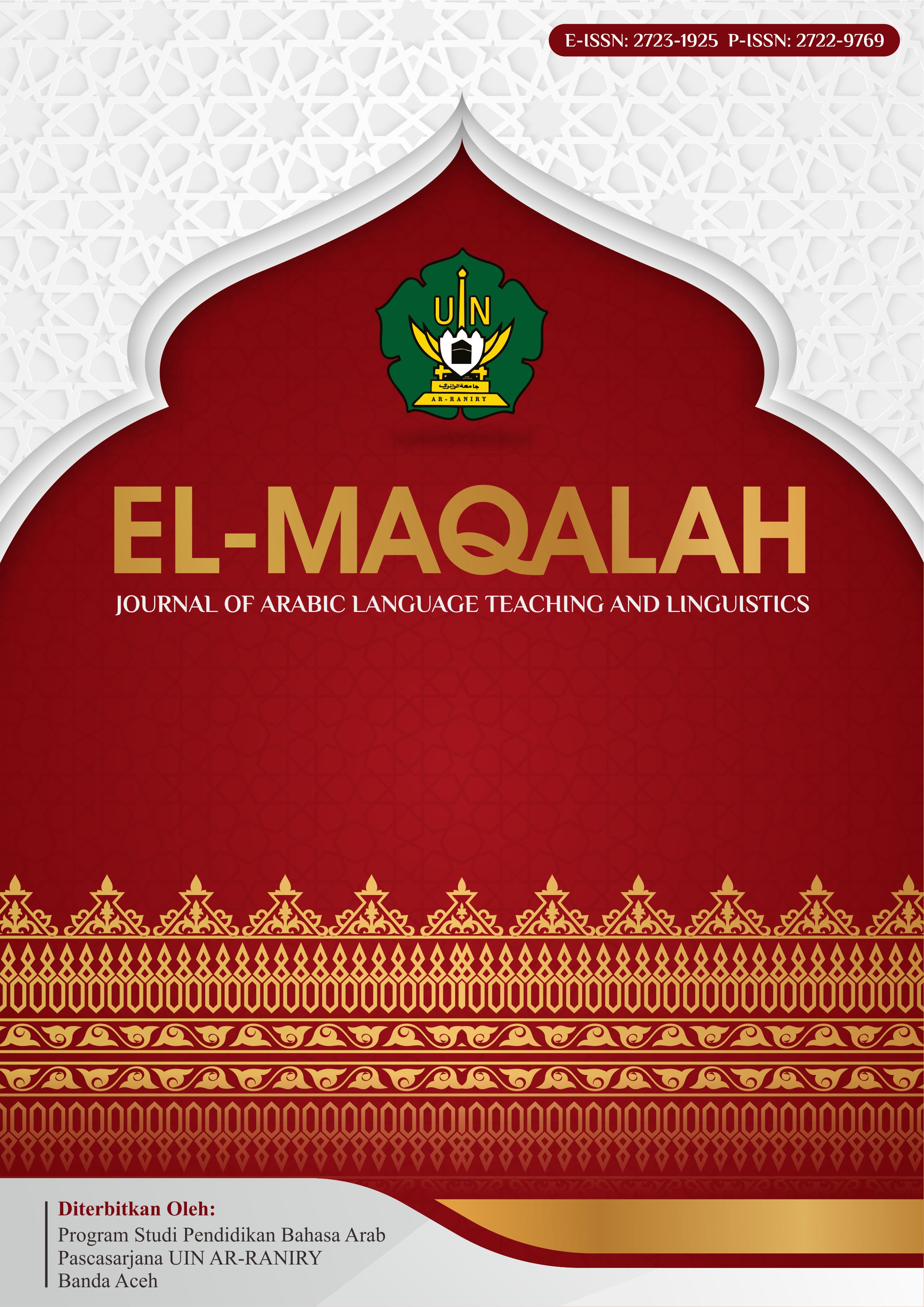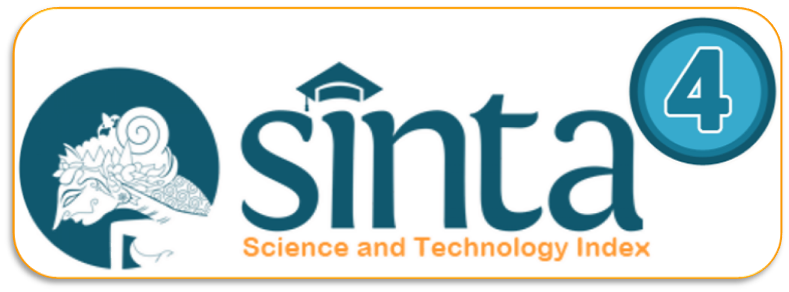Fa`āliah Ijrā’ aṭ-Ṭarīqah al-Istiqrāiyyah Bi Uslūb STAD Wa Wasīlah Biṭāqah al-As’ilah Wa al-Ajwibah Li Tarqiyah Qudrah aṭ-Ṭalabah Fī Ta`allum an-Naḥw (Dirāsah Tajrībiyah Bi Ma`had `Ulūm al-Qur’ān Aceh Besar)
(Aceh Besar دراسة تجريبية بمعهد علوم القرآن) ووسيلة بطاقة الأسئلة والأجوبة لترقية قدرة الطلبة في تعلم النحو STAD فعالية إجراء الطريقة الاستقرائية بأسلوب
DOI:
https://doi.org/10.22373/maqalah.v2i1.1240Keywords:
Inductive Methode, STAD, Question-Answer Flash Card, GrammarAbstract
Qawaid Nahwu is one of the most important aspects of learning Arabic, which is related to determining the function of each word in a sentence, as well as giving the final Tashkeel of each word and explaining the function of each word based on its position in a sentence. To achieve success in the learning process, a teacher is required to use methods, techniques, and teaching media to achieve learning objectives. Based on the research observation at the Ulumul Qur'an Boarding School in Aceh Besar, the researcher found that the Nahwu teacher at the pesantren used the book Al-Nahwu Al-Wadhih but he did not use learning media during the teaching-learning process, so students felt bored, such as lack of attention on the subject matter and some of them also interrupted the class during the teaching-learning process. On the other hand, boredom is also caused by the teacher not using appropriate techniques that are suitable for students in the teaching-learning process. This condition causes a lack of response from students during the learning process. Therefore, the researcher will try to apply inductive methods using STAD techniques and question-and-answer card media to improve students' abilities in learning Nahwu. The purpose of writing this thesis is to find out students’ responses to Nahwu learning by applying the inductive method using STAD techniques and question-and-answer card media in Nahwu learning and to know their effectiveness in increasing students' abilities in Nahwu learning. This study is an experimental study with a post-test-only control group design. The population in this study were all level students at the Ulumul Quran boarding school while the sample was all students of class 2a as a control group and 2c as an experimental group totaling 44 people. The instruments used were post-test and interview. To analyze the data in this study, testers used the t-test formula using the SPSS program. Based on the results of the study, the data shows that the use of inductive methods using STAD techniques and question-and-answer card media is effective in increasing the ability of students to learn Nahwu in the Ulumul Qur'an boarding school. This is evident from the results of the value Sig.0.00 <0.05. This shows that the hypothetical (Ho) is rejected and the alternative hypothesis (Ha) is accepted.
References
`Aṭiyū, Muḥammad Najīb Muṣṭafā. Ṭuruq Tadrīs al-`Ulūm Baina an-Naẓariyah Wa at-Taṭbīq. Ar-Riyāḍ: Maktabah ar-Rasyīd, 2007.
`Imāyirah, Khalīl Aḥmad. at-Taḥlīl al-Lughawī. al-Urdun: Maktabah al-Manār, 1987.
Al-`Arabī, Ṣalāḥ `Abd al-Majīd. Ta`allum al-Lughah al-Ḥayyah Wa Ta`līmuhā Baina an-Naẓariyyah Wa Taṭbīq. Maktabah Lubnān, 1981.
Al-`Assāf, Ṣālih Bin Ḥamad. al-Madkhal Ilā al-Baḥṡ Fii al-`Ulūm as-Sulūkiyah. Ar-Riyāḍ: Maktabah al-`Abīkān, 2000.
al-Ḥallāq, `Alī Samī. al-Marji` Fī Tadrīs Mahārāt al-Lughah al-`Arabiyah Wa `Ulūmihā. Lubnān: Mu’assasah al-Ḥadīṡah Li al-Kitāb, 2010
Arsyad, Azhar. Media Pengajaran, cet.II,Jakarta: Raja Grafindo Persada, 2000.
Aṣ-Ṣīnī, Maḥmūd Ismā`īl Wa `Umar aṣ-Ṣadīq`Abd Allāh. al-Mu`ayyināt al-Baṣariyah Fī Ta`līm al-Lughah. Ar-Riyāḍ: Maktabah al-`Arabiyah as-Su`ūdiyah, 1404 H/ 1984 M.
Fauzi, Mastur. Ragam Metode Mengajarkan Eksakta pada Murid, Jogjakarta: Diva Press, 2013.
Ghulāyainā, Muṣṭafā. Jāmi` ad-Durūs al-`Arabiyah. al-Juz al-Awwal. Bairūt: Mansyūrāt al-Maktabah al-`Aṣriyah, 1987.
Ismāīl, Zakariyyā. Ṭuruq at-Tadrīs al-Lughah al-`Arabiyah. Al-Qāhirah: Dār al-Ma`rifah al-Jāmi`ah, Dūn as-Sanah.
Khāṭir, Muḥmūd Rusydī Wa Ākharūn. Ṭuruq Tadrīs al-Lughah al-`Arabiyah Wa at-Tarbiyah ad-Dīniyah Fī Ḍau’ al-Ittijāhāt at-Tarbawiyah al-Ḥadīṡah. al-Qāhirah: Dār al-Ma`rifah, 1998.
Lāfī, Saīd. Ta`līm al-Lughah al-`Arabiyah al-Mu`āṣirah. Al-Qāhirah: `Ilm al-Kutub, 2015 M.
Ma`rūf, Nāyif Maḥmūd. Khaṣāiṣ al-`Arabiyah Wa Ṭarāiq Tadrīsihā. Lubnān: Dār an-Nafāis, 1998 M.
Muḥammad, Abī al-Faḍl Jamāl ad-Dīn. Lisān al-`Arab. al-Mujallad al-`Āsyir. Bairūt: Dār Ṣādir-Bairūt, Dūn as-Sanah.
Mujib, Fathul dan Nailul Rahmawati, Metode Permainan–Permainan Edukatif dalamBelajar Bahasa Arab, Jogjakarta: penerbit DIVA Press, 2011.
Suprijono, Agus. Cooperatif Learning Teori dan Aplikasi PAIKEM, Yogyakarta: Pustaka Pelajar, 2009.
Syaḥātah, Ḥasan. Ta`līm al-Lughah al-`Arabiyah Baina an-Naẓariyah Wa aṭ-Ṭaṭbīq. ad-Dār al- Miṣriyah al-Lubnāniyah, 1992.
Ṭa`īmah, Rusydī Aḥmad. Ta`līm al-`Arabiyah Lighair an-Nāṭiqīn Bihā Manāhijuhu Wa Asālībuhu. Makkah Mukarramah: Mansyūrāt al-Munaẓẓamah al-Islāmiyah Li at-Tarbiyah Wa al-`Ulūm Wa aṡ-Ṡaqāfah, 1985.
Yūsuf, Māhir Ismāīl Ṣabrī Muḥammad. al-Madkhal Li al-Manāhij Wa Ṭuruq at-Tadrīs. Ar-Riyāḍ: Maktabah asy-Syarqī, 2010 M.




























